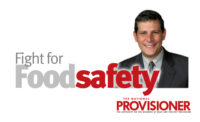As government and industry strive to improve the safety of our food supply, not a day goes by when we don’t hear about more legislation, added regulation and new policy.
How about newly created tax incentives?
Although FSIS oversight has substantially improved the safety of our food supply, the regulatory system under which we operate in some ways disincentivizes food safety.
In the absence of any single solution to guarantee the elimination of pathogens from food, the best way to control pathogens is to design effective interventions, validate those interventions, and perform verification testing on affected products. The problem in the beef industry, however, is that looking for and then finding pathogens can be extremely expensive.
At the harvest level, establishments that test trimmings are required to divert positive product to cooking or rendering. Common sense tells us that the more companies test, the more pathogens they will find, the more product they will divert and the more revenue they will lose. Unfortunately, this may be viewed by some within industry as an incentive to avoid finding contamination which may in fact exist. This of course can also put any companies which are testing appropriately and aggressively at a competitive disadvantage.
At the processing level, where testing is not mandated, many companies have nevertheless put in place finished product testing programs as a means to further enhance safety. When contamination is found, however, difficult decisions must be made regarding which products are potentially affected and how they will be disposed. Here too, such decisions can be very costly.
One solution to overcome the financial deterrent to testing and diverting positive products is to reward companies that are aggressively testing. Congress should consider creating additional tax incentives for testing, research and quality control, and also create meaningful tax credits which would extend to any positive products diverted from their original intended use.
Such a system would accomplish multiple goals. Not only would our food become safer, but by reducing production costs through the use of tax credits and incentives to offset losses from positive product, our food supply would become more plentiful and affordable as well.A








Report Abusive Comment